
HB365LC-3 Hybrid Komatsu excavator helps reduce your carbon footprint with lower emissions PUSHINGAHEAD A publication for and about Clairemont Equipment customers • www.CECPushingAhead.com March 2023 A publication for and about Clairemont Equipment customers • www.CECPushingAhead.com
Fuel savings, reduced emissions
Dear Valued Customer:
While prices at the pump have dropped for gasoline, diesel remains stubbornly high. There are many ways to reduce fuel usage such as idling less and shutting machines down when they will be out of service for extended periods of time.
Choosing the right equipment for the job can also help ensure maximum productivity and fuel efficiency. On traditional dirt jobs that involve digging, swinging and loading, a solid option is Komatsu’s innovative Hybrid HB365LC-3 excavator that converts swing braking into electric energy that is stored and used to provide swing power. Compared to standard machines, the hybrid can also cut emissions significantly, which helps reduce your carbon footprint and improve sustainability measures.
Speaking of innovation, no one does it quite like Komatsu with its suite of Smart Construction solutions. Check out the articles on how Drone, Dashboard and Remote are helping customers save time and reduce costs with the increased efficiencies these solutions provide. Another piece highlights the Smart Construction and Smart Quarry Demo Days Komatsu recently held in Cartersville, Ga.
Remember: If you don’t take care of your machines, they won’t take care of you. We offer some tips on battery maintenance and remanufactured NOx sensors that can be useful to your operation.
That has always been our mission — to provide you with helpful information, the best equipment and world-class service. We will continue to do so in 2023 and beyond.
As always, if there is anything we can do for you, please feel free to contact us.
Sincerely,
Clairemont Equipment Company
Ronald Zagami, President

Message from the President
A
2
Ronald Zagami
PUSHINGAHEAD
www.CECPushingAhead.com
Providing Equipment Rentals, Sales, Service and Parts.

Corporate Office
(858)278-8351
Mon.-Fri., 8:00-5:00
San Diego
Parts: (858) 278-8351
Mon.-Fri., 7:00-5:00
Customer Success Story pg. 5
See how Digby Construction LLC increases efficiency.
Industry Outlook pg. 6
Discover what is in store for the construction industry in 2023.
Guest Opinion pg. 9
Listen to Sam DeBaltzo's advice about liens.
Smart Construction pg. 10
Move earth faster and save money with Smart Construction solutions.
Greener Excavator pg. 12
Check out Komatsu's Hybrid HB365LC-3 excavator.
Customer Success Story pg. 14
Find out how Emery Sapp & Sons Inc. reduces costs.
Savings for You pg. 17
Take a look at Komatsu's genuine Reman NOx sensors.
Smart Showcase pg. 18
Learn about Komatsu's Smart Construction solutions, including its newest addition: Smart Quarry.
Battery Maintenance pg. 21
Follow these tips when handling batteries.
Industry Insight pg. 23
Stay up to date on industry news.
www.clairemontequipment.com
(Corp) San Diego 7651 Ronson Road (858)278-8351
San Diego 4726 Convoy Street (858)278-8338
Escondido 1330 Mission Road (760)739-9100
Fontana 8520 Cherry Avenue (909) 429-9100
Indio 81-501 Industrial Place (760) 863-5558
Imperial 440 W. Aten Road (760) 355-7700
Rentals: (858) 278-8338
Mon.-Fri., 6:30-5:00 • Sat., 7:30-4:00
Lance Clark, Branch Manager
Dave Sales, Rental Developer
Barry Mann, Rental Developer
Sales: (858) 278-8351
Mon.-Sat., 8:00-5:00
Bill Hamel, Area Sales Rep.
Ken Birch, Area Sales Rep.
Kim McMurtray, Area Sales Rep.
Misti Kummerfeld, Area Sales Rep.
Paul Kelly, Area Sales Rep.
Paul Lull, Area Sales Rep.
Thomas Beny, Online Used Equipment Sales
Service: (858) 278-8351
Mon.-Fri., 7:00-3:30
Mark Zagami, Fleet/Service Manager
Escondido
Parts, Sales & Service: (760)739-9100
Mon.-Fri., 6:30-5:00
Greg Seidler, Parts & Service Manager
Rentals: (760) 739-9100
Mon.-Fri., 6:30-5:00 • Sat., 7:30-4:00
Jason Williams, General Manager
Carl Robbins, Rental Developer
Fontana
Parts, Rentals, Sales & Service: (909)429-9100
Mon.-Fri., 6:30-5:00
Michael Lopez, Parts Manager
Daniel Solomon, Rental Developer
Jason Mears, Rental Developer
Indio

Rentals, Sales & Service: (760)863-5558
Mon.-Fri., 6:30-5:00 • Sat., 7:30-4:00
Brian Dawson, Branch Manager
Jesus Rodriguez, Rental Developer
Imperial Parts, Rentals, Sales & Service: (760)355-7700
Mon.-Fri., 6:30-5:00
Arturo Estrada, Branch Manager
Jesse Ferrusquia, Rental Developer
Your One-Stop Dealer…
Not all products represented at all locations.
In this issue Published for Clairemont Equipment Company. © 2023 Construction Publications Inc. Printed in the USA.
3
Have you seen what’s new in My Komatsu?
We’ve made some exciting changes! An all-new mobile app, simplified ordering through the Online Parts Store, Komatsu Care Program (KCP) integration and more have been added to enhance the My Komatsu user experience.
Log in to your My Komatsu account to see the full range of new features. Don’t have a My Komatsu account? Go to mykomatsu.komatsu to sign up.
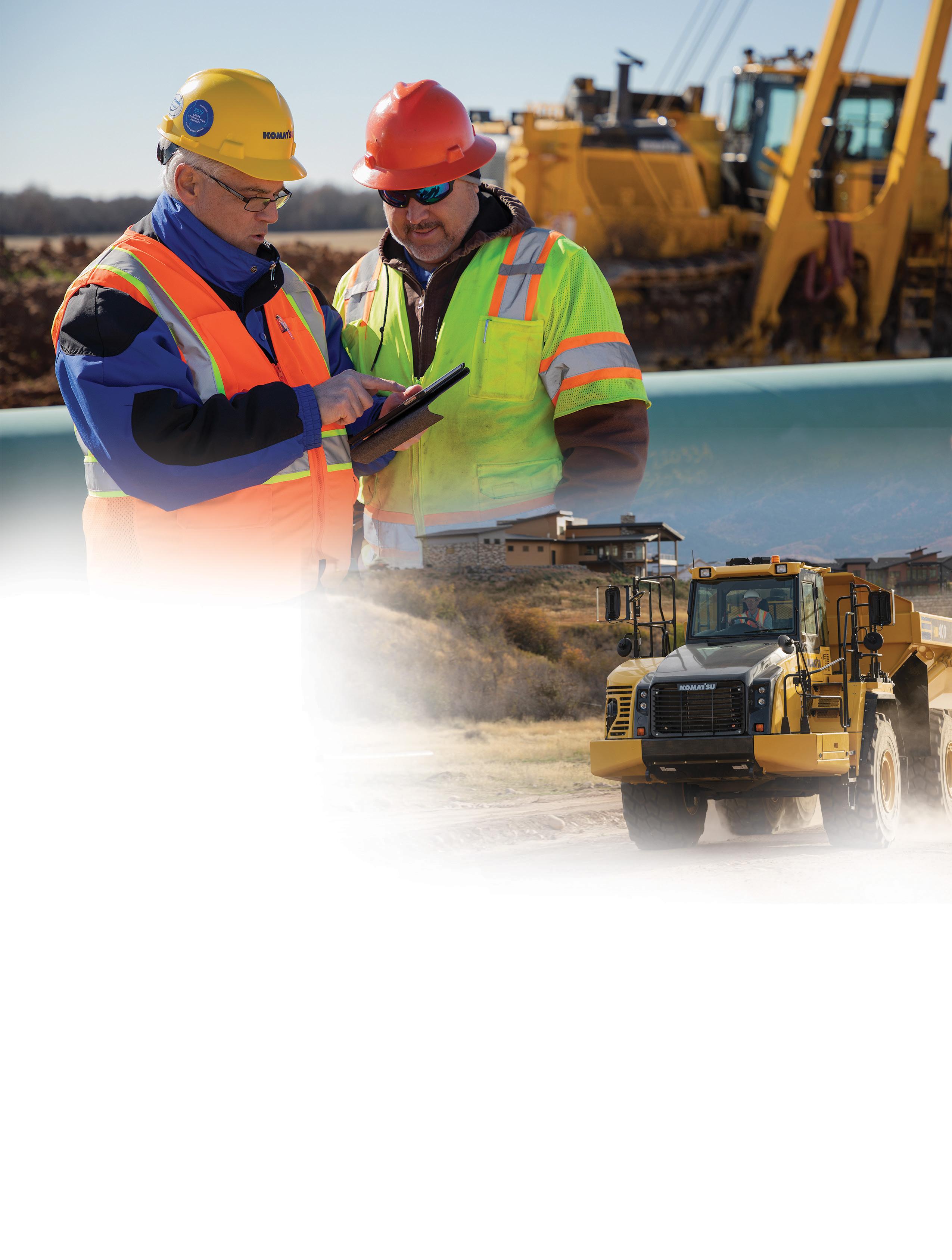
Digby Construction LLC sees increase in cost savings and operational efficiency with Komatsu iMC dozers
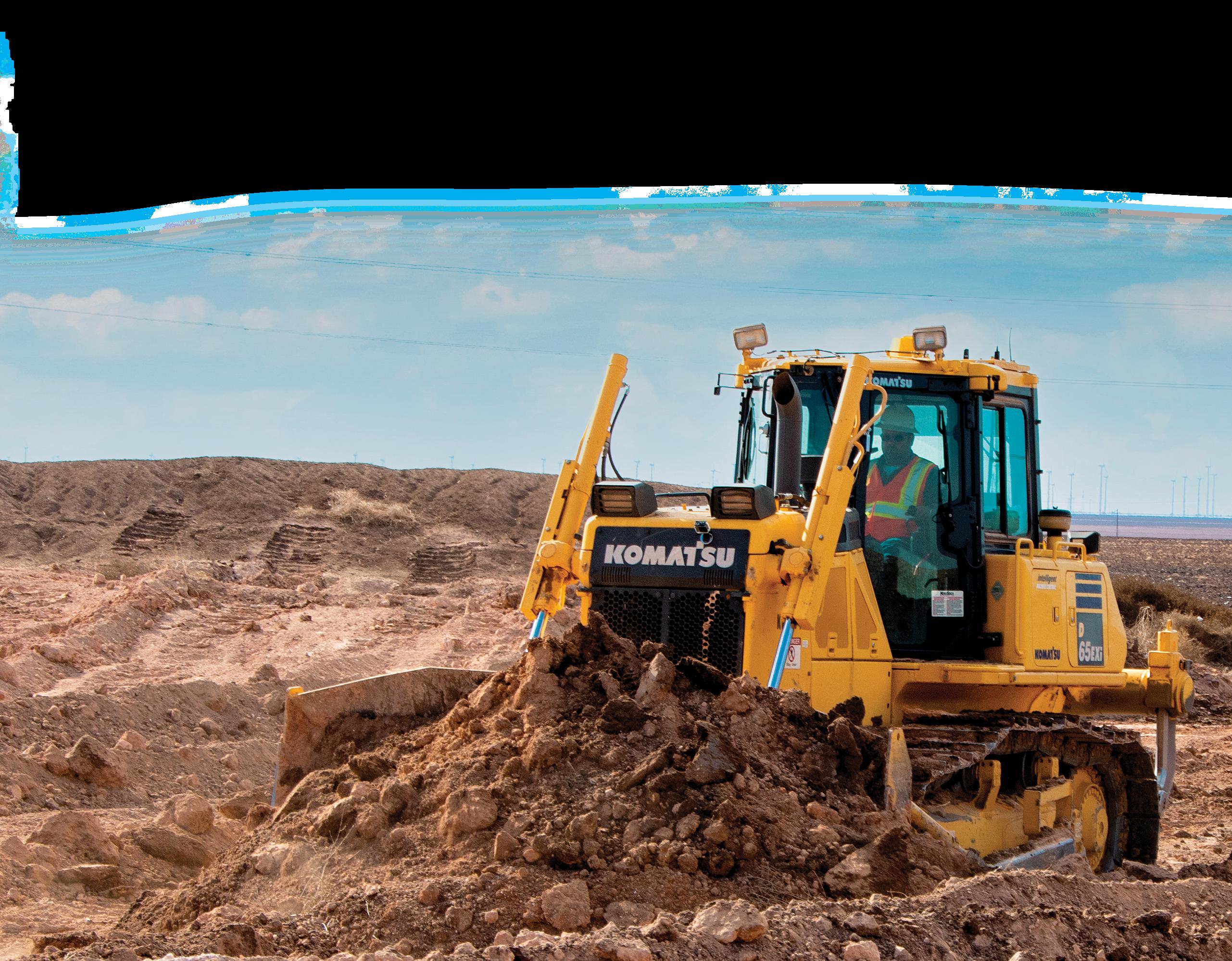
BBilly Digby has always loved equipment and playing in the dirt. Digby views construction as an art form and operates an earthwork-focused company.
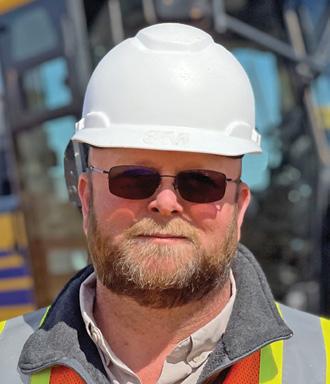
“It’s the concept of taking nothing and making it into something,” Digby noted. “It’s in my veins, and I couldn’t really see myself doing anything else. I spent about 10 years as a general manager for another company then decided to go out on my own. Even though we have grown quite a bit during the past few years, I’m still very hands-on. I’m not a sit-behind-the-desk kind of guy; never have been and never will be.”
Building with intelligence
Technology has played an increasing role in Digby Construction’s processes, and about two years ago, it added a couple of Komatsu D65EXi-18 intelligent Machine Control (iMC) dozers with integrated GPS grade control to its fleet. The company also recently purchased a Komatsu GD655 motor grader equipped with an aftermarket Topcon GPS system.
“We demoed the first intelligent dozer,” recalled Digby. “An average pad would take around 10 days, but with that machine, the
time was cut in half. Obviously, that was a game changer for us because the profit margin went up. Now, we visit a site, take some shots and build a model. That gets plugged into the dozers and grader, and we go from there.”
General Manager Casey Settle said the dozers and motor grader have not only sped up site construction but lowered the company’s owning and operating costs.

“We engineer the site as far as grade and how it drains,” explained Settle. “After we clear, we put the iMC dozers to work roughing in the location, building pits, putting the pad to grade, and laying the base material.
“Once we download the site plan to the machine and do a quick calibration, it’s a matter of letting the machines do the work,” Settle continued. “They know where they are in relation to final grade at all times and are highly accurate, so there is no guesswork or a need for a grade checker. Our time, material and fuel cost savings have been significant.” ■
**The opinions expressed here are from the end users who are quoted.

5 Customer Success Story
Billy Digby, Owner
Casey Settle, General Manager
Watch the video
Digby Construction’s Komatsu D65EXi-18 intelligent Machine Control (iMC) dozers help increase efficiency. “An average pad would take around 10 days, but with that machine, the time was cut in half,” said Billy Digby, owner of Digby Construction.
IIn late 2021, President Joe Biden signed the $1.2 trillion Infrastructure and Investment Jobs Act (IIJA) into law, which was a historic investment in the nation’s infrastructure and transportation funding. The Bipartisan Infrastructure Law has had a positive effect and will continue to do so in 2023, according to several construction industry professionals as they forecast this year’s outlook.
During testimony before the Environment & Public Works (EPW) Committee in late 2022, American Road & Transportation Builders Association (ARTBA) President and CEO Dave Bauer told senators that 29,000 transportation improvement projects are moving forward thanks to the Bipartisan Infrastructure Law. Bauer highlighted ARTBA’s economic analysis, showing that highway formula funds supported 2,500 more safety, mobility and maintenance improvements in 2022 than in 2021, while the number of $100 million projects increased from 18 in 11 states to 24 in 14 states.
“Though each project has a unique story of need and solution, they are all tangible illustrations of the impacts underway from the leadership of this committee in delivering generational investments through
a multiyear surface transportation program reauthorization,” said Bauer.
The Bipartisan Infrastructure Law reauthorized surface transportation programs for five years, investing $110 billion in America’s aging roads and bridges.
ARTBA estimated that highway and bridge construction spending will increase 13.4% this year to a total of $119 billion, according to the article “2023 Forecast: Markets are Mixed for Year Ahead” published by Engineering News-Record (ENR). Dodge Data & Analytics Inc. is even more optimistic, predicting new starts will be as high as 20%, thanks to infrastructure funding. That would be an increase beyond the 23% rise Dodge forecast for the end of 2022.
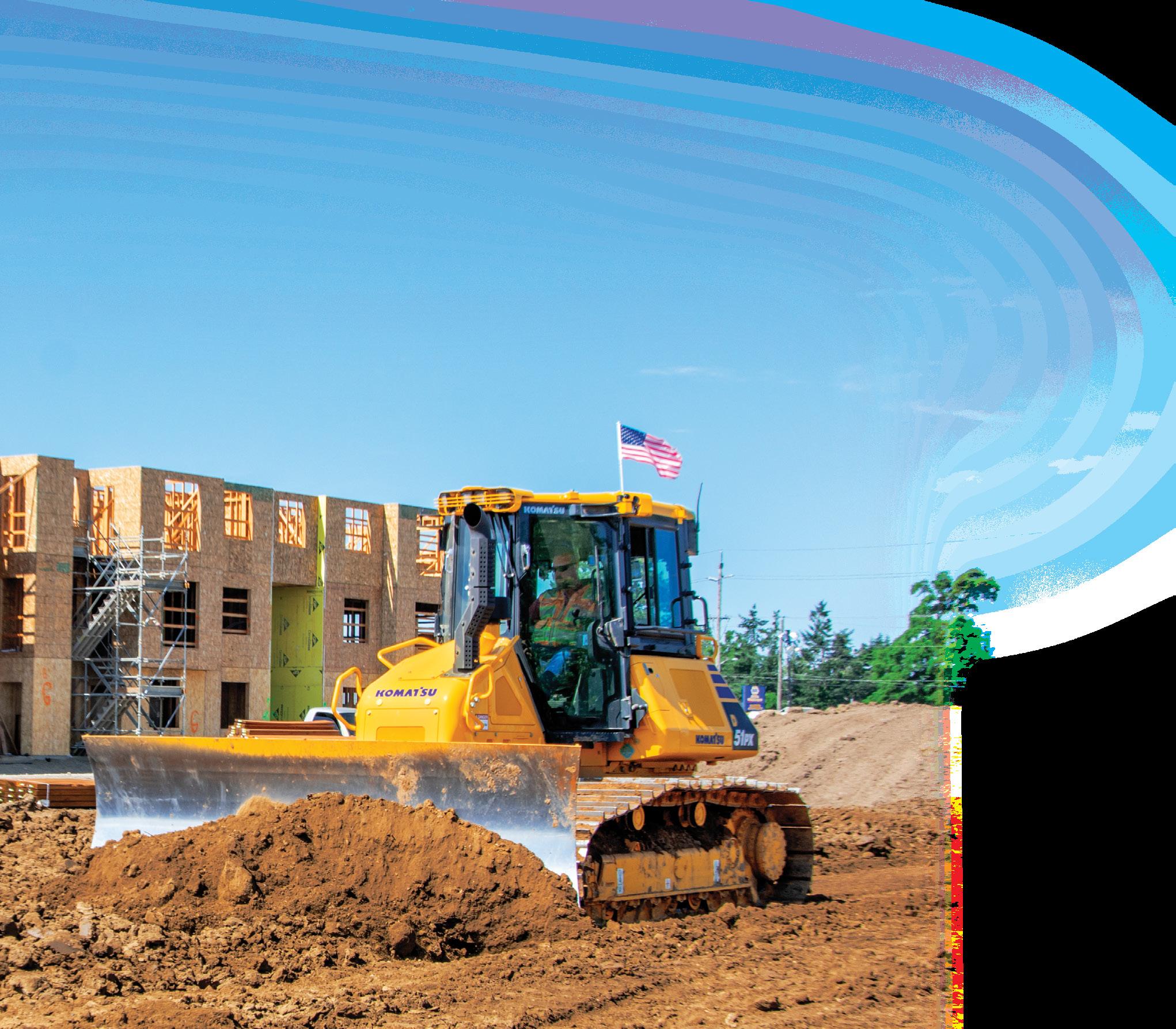
Dodge Chief Economist Richard Branch pointed out that only 19% of funding from the Bipartisan Infrastructure Law had been allocated by late last year.
“There’s a lot of money still on the table waiting to be spent,” said Branch in the Equipment World article “Dodge Economist: Prepare for a Rocky First Half of 2023.” “We continue to think 2023 and 2024 are the best years for infrastructure construction. But, I could foresee, again, if we have appropriation delays, that maybe 2024 and 2025 are the best years.”
Modest downturn, quick recovery

Infrastructure projects are bright spots in the overall construction industry, which has been slowed by several factors during the past year. Dodge sees it as relatively flat in 2023, with a slight decline. Fails Management Institute (FMI) forecasts a 1.3% decline.
“I don’t think this is another great recession,” said Jay Bowman, Principal of Industry Management Consultant for FMI in the ENR article. “I’ll take flat over down any day of the week.”
Branch noted that inflation will be a big factor going forward, along with other causes for concern such as the war in Ukraine and oil production cuts by the Organization of the Petroleum Exporting Countries (OPEC). Branch’s forecast assumes that core inflation will improve, and there will not be any major shocks. If his predictions are correct and everything remains stable, Branch believes a “technical
Multifamily housing appears to be a bright spot in the residential sector. Dodge predicts a 1.4% rise in starts, while FMI sees a nearly 6% jump.
6 Industry Outlook
Bipartisan Infrastructure Law positively impacts transportation, overall forecast is mainly flat due to inflation concerns
recession” could be avoided with economic stabilization and recovery starting in the latter half of 2023. He added that a strong banking system and undersupplied housing market are favorable for the construction industry.
“We’re sitting at 14- to 15-year highs in the Dodge Momentum Index, so it should provide some semblance of confidence and reassurance that developers and owners are continuing to put projects into the queue despite the fact that we’re concerned about what might happen when interest rates keep rising and the economy slows down in 2023,” said Branch.
In its most recent outlook, the Portland Cement Association (PCA) projected a near-term demand decline of about 3.5% for 2023, the first decline in 13 years. It expects the slowdown to be short, with growth returning in 2024.
“Due to inflation and rising interest rates, economic growth is expected to remain sluggish through mid-2023 with unemployment
reaching 4.7%,” said Edward J. Sullivan, PCA Chief Economist and Senior Vice President. “Inflation is expected to remain high, leading to further monetary policy tightening through this year and into early next.”
Sector gains
While both Dodge and FMI predict overall construction starts to be down in 2023, both foresee increases within several sectors. Dodge predicts a slight increase in total residential construction, including 1.4% in the multifamily category. FMI anticipates a nearly 6% jump in multifamily, despite overall residential starts being lower.

Dodge and FMI have opposing outlooks on total non-residential as well. FMI is optimistic of a 4.4% rise, led by the manufacturing sector with a jump of 15.4%. It sees lodging, amusements and recreation, education, health care, commercial and public safety all getting boosts. Dodge predicts increases for hotels and motels, stores and shopping centers, and education. ■
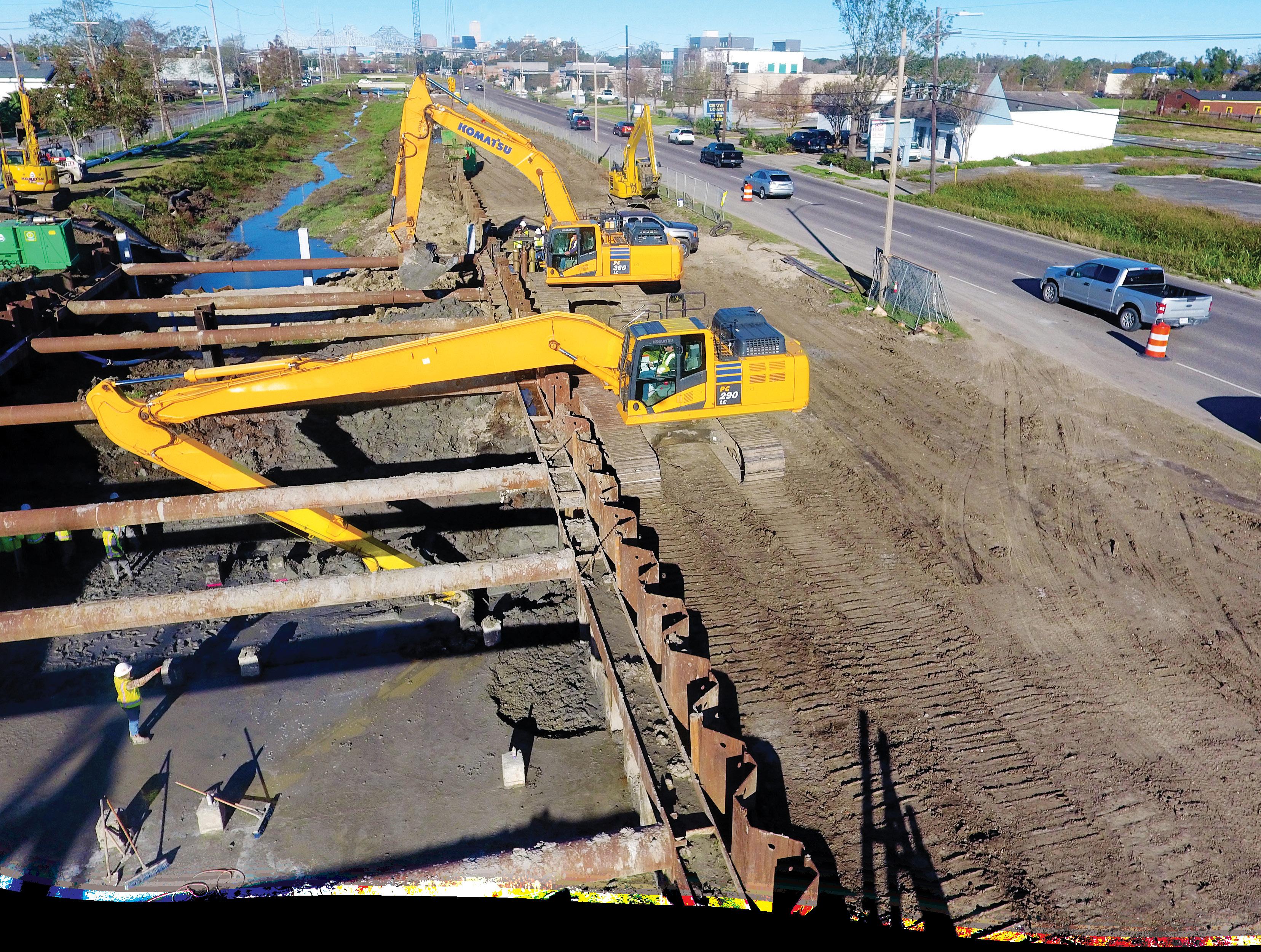
7
The Bipartisan Infrastructure Law will give a boost to projects such as roads, bridges, canals, broadband, utility upgrades and more in 2023, according to industry forecasters. ARTBA estimated that highway and bridge construction spending will increase 13.4% this year to a total of $119 billion. Dodge is even more optimistic, predicting new starts to be as high as 20%, thanks to infrastructure funding.



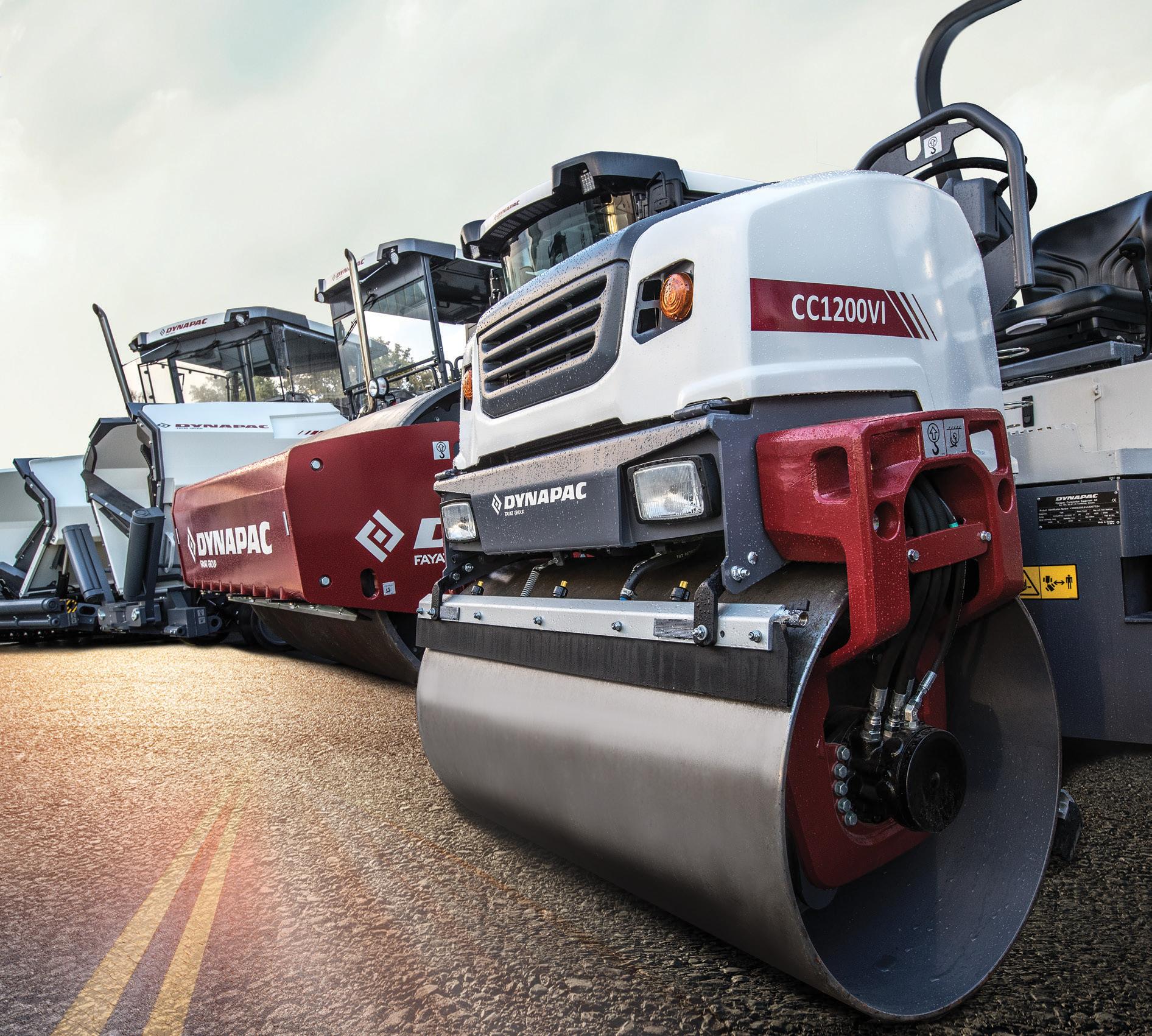
dynapac.us | 800-651-0033 Designed to perform, Built to last Follow Dynapac North America Confidence and Reliability starts and ends with Dynapac! Your Partner on the Road Ahead. (Corp) San Diego 7651 Ronson Road (858) 278-8351 San Diego 4726 Convoy Street (858) 278-8338 Escondido 1330 Mission Road (760) 739-9100 Fontana 8520 Cherry Avenue (909) 429-9100 Indio 81-501 Industrial Place (760) 863-5558 Imperial 440 W. Aten Road (760) 355-7700 www.clairemontequipment.com
Subcontractors, don’t waive your right to a lien
IIn the course of reviewing construction subcontracts, I’ve recently seen provisions similar to the following (simplified for convenience and confidentiality):
• “The subcontractor shall reimburse the [contractor and/or owner] for any costs and expenses for any claim, obligation, or lien that arises from the performance of the work.”
• “The subcontractor shall remove and discharge any lien, claim, security interest, or other encumbrance related to the subcontractor’s performance of the work.”
The provisions are often followed with boilerplate requirements for paying the third-party claimant, bonding, reimbursement of attorneys’ fees, indemnification responsibilities, or other ways of providing security to the owner or general contractor.
The purpose of these types of provisions is clear: Owners want their projects completed free of liens, and they want the person responsible for the work to make sure that happens. This is an understandable position, and it is reasonable for any construction contract to require lien waivers. The problem is that these provisions do not require payment prior to the waiver.


Yes, if a subcontractor is paid, it should agree to keep the project clear of liens and remove any
liens filed by its respective subcontractors or suppliers. But, until payment has occurred, retaining the powerful lien right is essential for any prudent subcontractor. Whether intentional by the drafting party or not, these provisions suggest the subcontractor is agreeing to waive its lien rights even when the owner or contactor fails to pay.
Simple solution
With these specific provisions, I find the solution is simple and relatively unobjectionable; I like to add “provided subcontractor has been paid for the work” at the beginning of the phrase. Subcontractors should be on the lookout for these and other potential pitfalls, and make sure they do not unwittingly leave themselves unprotected by accepting provisions that are inherently unfair. ■
About the Author: Sam DeBaltzo has a wide variety of experience representing clients in real estate transactions and the purchase, sale and leasing of real property. He additionally provides counsel in several related industries, working routinely with construction, architect and engineering contracts. His business law experience includes general corporate matters and representation of both for-profit and non-profit businesses in mergers, acquisitions and dispositions. For more information, visit tonkon.com.
Until payment has occurred, retaining the powerful lien right is essential for any prudent subcontractor.
9 Guest Opinion
Sam DeBaltzo, Associate Attorney, Tonkon Torp LLP
Smart Construction solutions, iMC help Castle’s Renewable Energy Division move earth faster with decreased costs
TThe company known today simply as Castle was originally founded as Progressive Pipeline in 1999 by Mike Castle Sr. His business focused on providing service to the oil and gas industry with jobs done with integrity, on time and on budget. That strategy proved highly successful, and within three years, the company landed its first multimillion-dollar contract, which led to the creation of more divisions within the firm.
In addition to Pipeline, Castle’s divisions now include an Integrity Group, a Facility Group, Directional Drilling, Environmental Reclamation, and its latest undertaking: Renewable Energy, which focuses on sitework and other services for wind and solar projects.
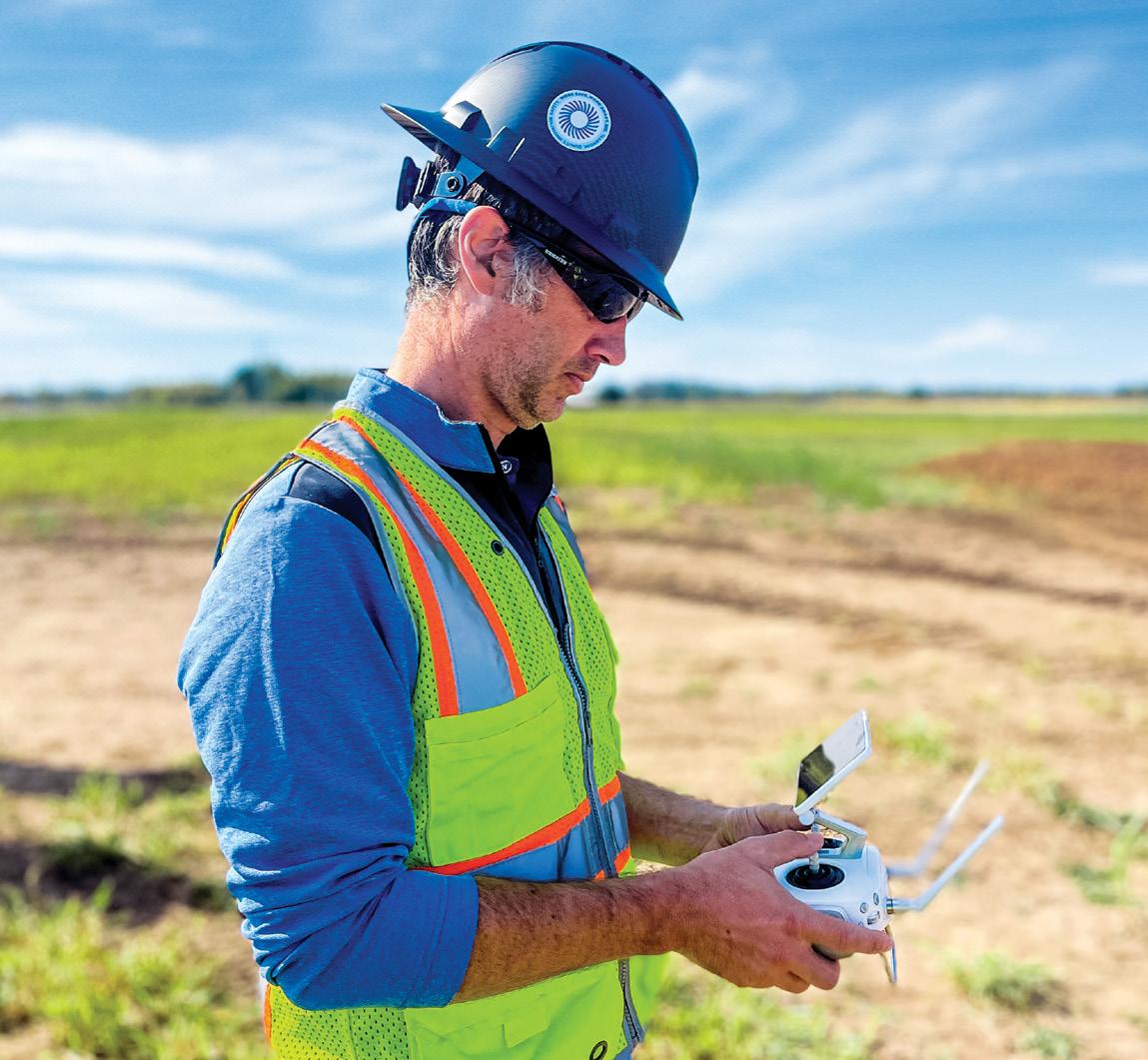
“Castle saw the transition to renewables and wanted to be a part of that,” said Vice President Chris Scheve, who joined the company about a year ago and has helped spearhead the formation and expansion of the Renewable Energy Division. “With our skilled workforce and our equipment, it’s a nice fit to move over and do the renewables effort.”
Joel Brewton, Vice President of Asset Management & Centralized Services, added, “Outstanding service is our hallmark, and that’s really built around doing things safely and efficiently. We believe that goes hand in hand with delivering solid production. We are


always seeking ways to improve our practices. Technology — such as the Komatsu Smart Construction machinery and solutions we now use — is playing an increasingly bigger role for us because we see the benefits it is delivering in terms of cost and time savings.”
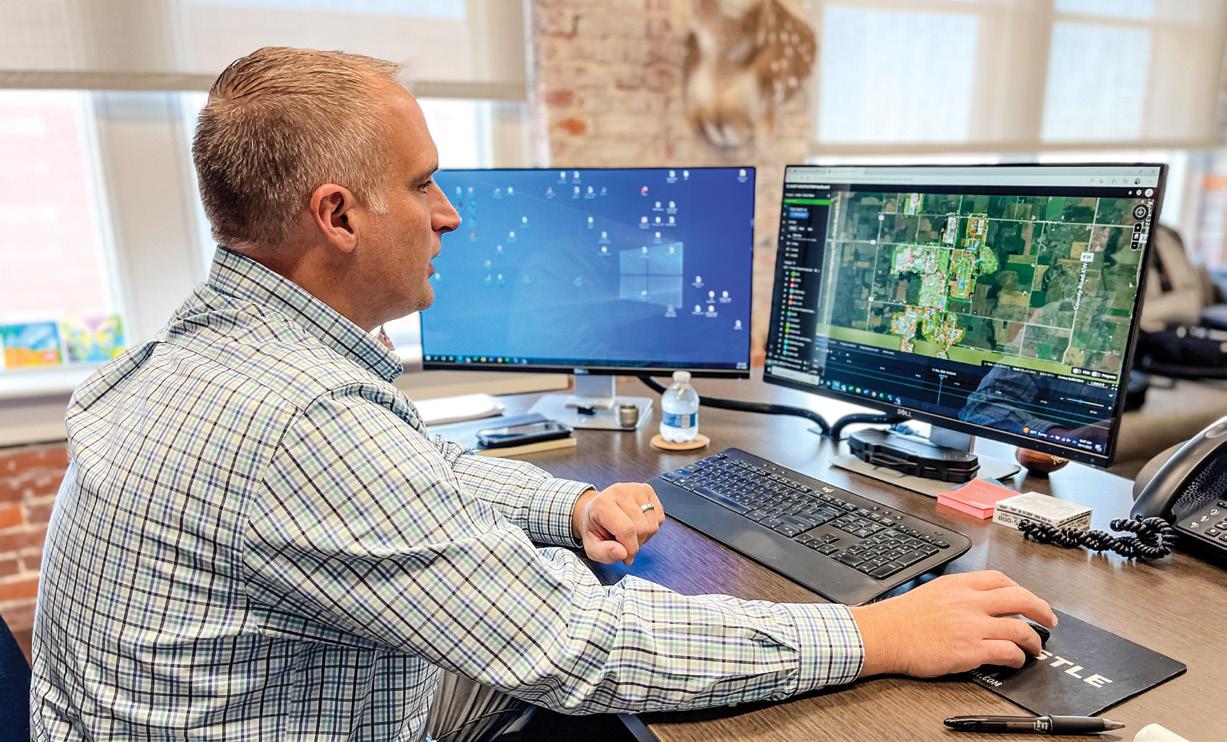
Brewton and Scheve emphasized that the two large solar projects that Castle’s Renewable Energy Division recently took on in Wisconsin are prime examples. About a year ago, Castle began site preparation, including putting the sites to grade, building basins, and handling erosion control. Between the two, Castle team members moved about 700,000 yards of dirt.
“Our Onion River project, which is the bigger of the two, involved about 18 different sites, so it was pretty spread out,” explained Superintendent Rocky Hartwick. “We started in July and had the mass grading done by the end of the year. Our Crawfish River project began earlier, and the grading was basically done within a relatively short timeframe.”
Hartwick continued, “These projects were our first ones using Komatsu’s intelligent machines, and we were very impressed with the ability to use the integrated GPS from grass to grade. Using traditional methods, we cut approximately two acres to grade each day. Komatsu’s intelligent machines allowed us to
 Komatsu’s Jason Anetsberger (left) uploads data from the Smart Construction Drone flights to Smart Construction Dashboard. Castle’s Joel Brewton (right) uses Komatsu’s Smart Construction Dashboard in his office in Meridian, Miss., to check the progress of Castle’s job sites in Wisconsin.
Chris Scheve, Vice President, Renewable Energy
Komatsu’s Jason Anetsberger (left) uploads data from the Smart Construction Drone flights to Smart Construction Dashboard. Castle’s Joel Brewton (right) uses Komatsu’s Smart Construction Dashboard in his office in Meridian, Miss., to check the progress of Castle’s job sites in Wisconsin.
Chris Scheve, Vice President, Renewable Energy
10
Joel Brewton, Vice President of Asset Management & Centralized Services
Smart Construction
do 10 to 12 acres without the need for a grade checker because the machines always know where they are in relation to final grade. The accuracy and efficiency are spot on.”
Using Smart Construction solutions
Throughout the projects, Castle has used Komatsu intelligent Machine Control (iMC) dozers and excavators, as well as Smart Construction Drone, Smart Construction Dashboard and Smart Construction Remote. Castle also purchased its own drone, and staff members received training from Komatsu, so they could conduct flights independently.
“Komatsu corporate has been a big part of helping us learn the intelligent system as well as incorporating drone flights to verify that what the machines are seeing is exactly what we’re seeing,” Scheve explained. “We’ve made drone flights a standard, so before we ever move a speck of dirt, we do an initial flight of the sites to make sure we have accurate models to work from. CAD (computer-aided design) files are developed from those, and those models are uploaded to the intelligent machines. We do subsequent flights about a month apart to check progress and verify how much dirt was moved, and that gets uploaded to Dashboard. That information helps us put together as-built models we can show to the customer and keep accurate records.”
Brewton said that level of accuracy has been impressive to Castle and its customers.
“We are a very schedule-driven contractor,” Brewton stated. “When we make a schedule, we want to stay on it. Drone flights let you verify a site within a matter of hours rather than days with the old methods of walking the site and staking it. Instead of taking maybe 20 shots with a rover and a stick within a 10-foot section, the drone is shooting thousands of points in that same area, so it’s delivering a more accurate picture. Billing is another advantage we see. We don’t want to overcharge our customer or be underpaid. With the drone, you can verify exact quantities, and you get paid for exactly the work you’ve done, and that’s what we want.”

Additional adoption

Increased productivity and efficiency with Komatsu iMC machines and Smart Construction solutions on the Renewable Energy Division’s Wisconsin projects have encouraged the Castle team to expand their usage of technology.
“Recent legislation is only going to put additional significant dollars into renewables, and we have customers asking us for commitments for several years out; making the investment makes sense,” said Scheve. “We see the applications for the machines and solutions in our other divisions too, such as Pipeline, so we are looking into how to adopt it for those going forward.” ■
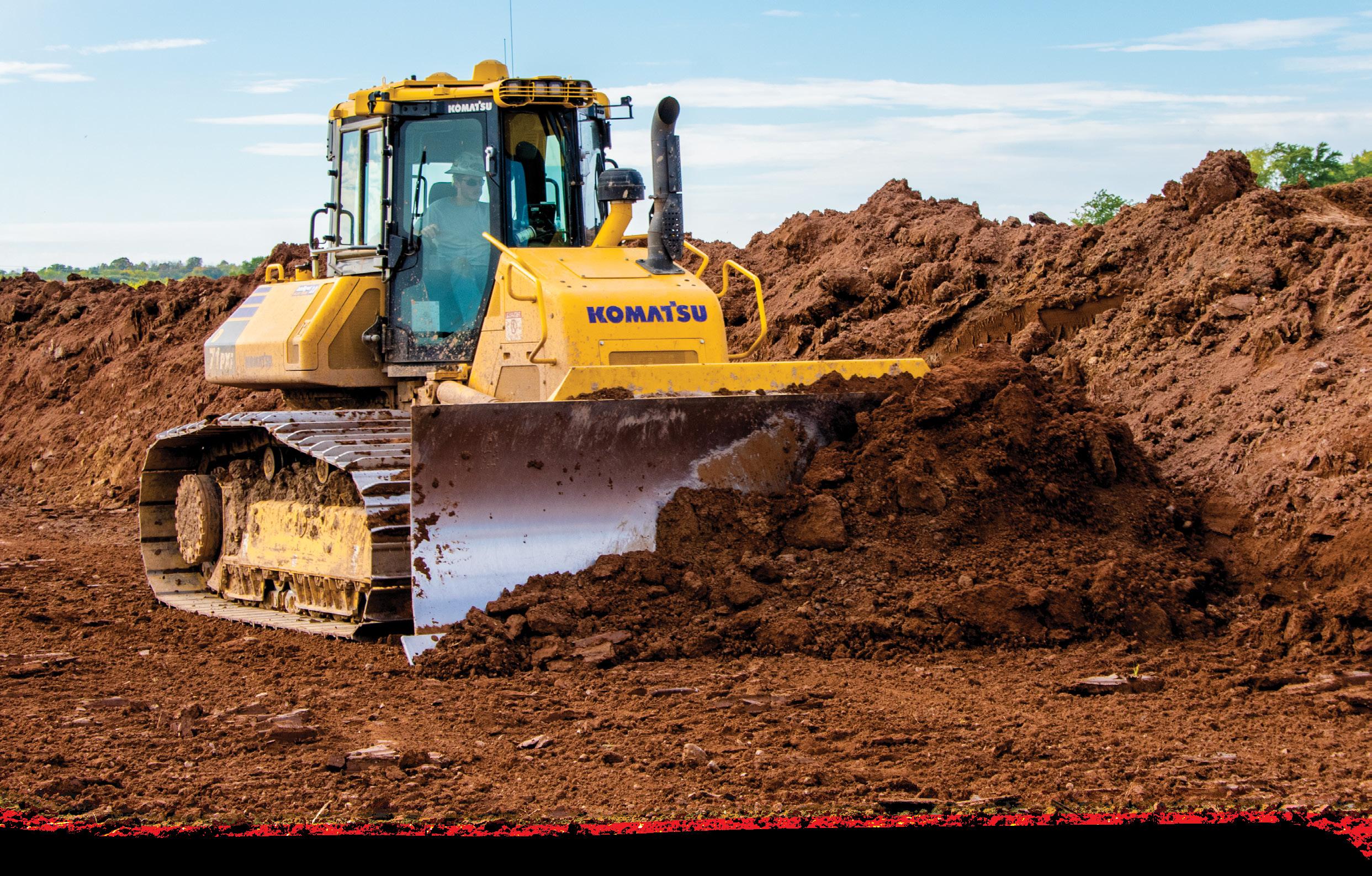 **The opinions expressed here are from the end users who are quoted.
**The opinions expressed here are from the end users who are quoted.
11
An operator cuts grade with a Komatsu D71PXi-24 intelligent Machine Control (iMC) dozer on Castle’s Onion River project near Adell, Wis. “We were very impressed with the ability to use the integrated GPS from grass to grade,” said Superintendent Rocky Hartwick. “The accuracy and efficiency are spot on.” Watch
the video
Hybrid HB365LC-3 excavator offers significant fuel savings and helps reduce your carbon footprint with lower emissions
LLooking for ways to increase production while reducing costs? In today’s economy with diesel prices higher than ever, using a hybrid excavator such as Komatsu’s Hybrid HB365LC-3 is a solid solution, according to Kurt Moncini, Senior Product Manager, Komatsu.

“Hybrid technology continues to grow and be adopted in the automotive world, and the construction industry is coming around to the benefits such as lower fuel costs and emissions,” said Moncini. “The HB365LC-3 offers increased fuel efficiency without sacrificing power, so the overall performance is outstanding. A topper on the cake is the added benefit of reduced emissions that lowers your carbon footprint and promotes sustainability.”
Moncini continued, “Based on EPA’s (Environmental Protection Agency) CO2 formula, the Hybrid potentially offers an up to 20% reduction in CO2 emissions compared to the standard PC360LC-11. It’s a big win all around.”
“The Hybrid HB365LC-3 has equal or better performance than our standard PC360LC excavator, but with fuel savings that could be as high as 20%, depending on application,” said Moncini. “It’s a great fit for construction companies that use excavators in high-swing applications, as well as for feeding crushers in quarry, recycling and demolition applications where swing is a constant.”
An electric swing motor captures and regenerates energy as the upper structure slows down and converts it to electric energy.
Moncini explained, “It’s using energy that would normally be wasted and makes it available to do work, contributing to increased efficiency and decreased diesel usage.”
Highly responsive
Komatsu recently improved the warranty on the HB365LC-3’s hybrid components to seven years or 15,000 hours. The warranty covers the electric swing motor, motor-generator, capacitor and inverter.
Komatsu introduced the 36-ton Hybrid HB365LC-3 — the industry’s first true hybrid in that class size — in 2017. Since then, thousands have been used around the world for all types of excavation, loading trucks and to perform other tasks. The HB365LC-3 followed the introduction of Komatsu’s first hybrid excavator, which was launched in 2008.
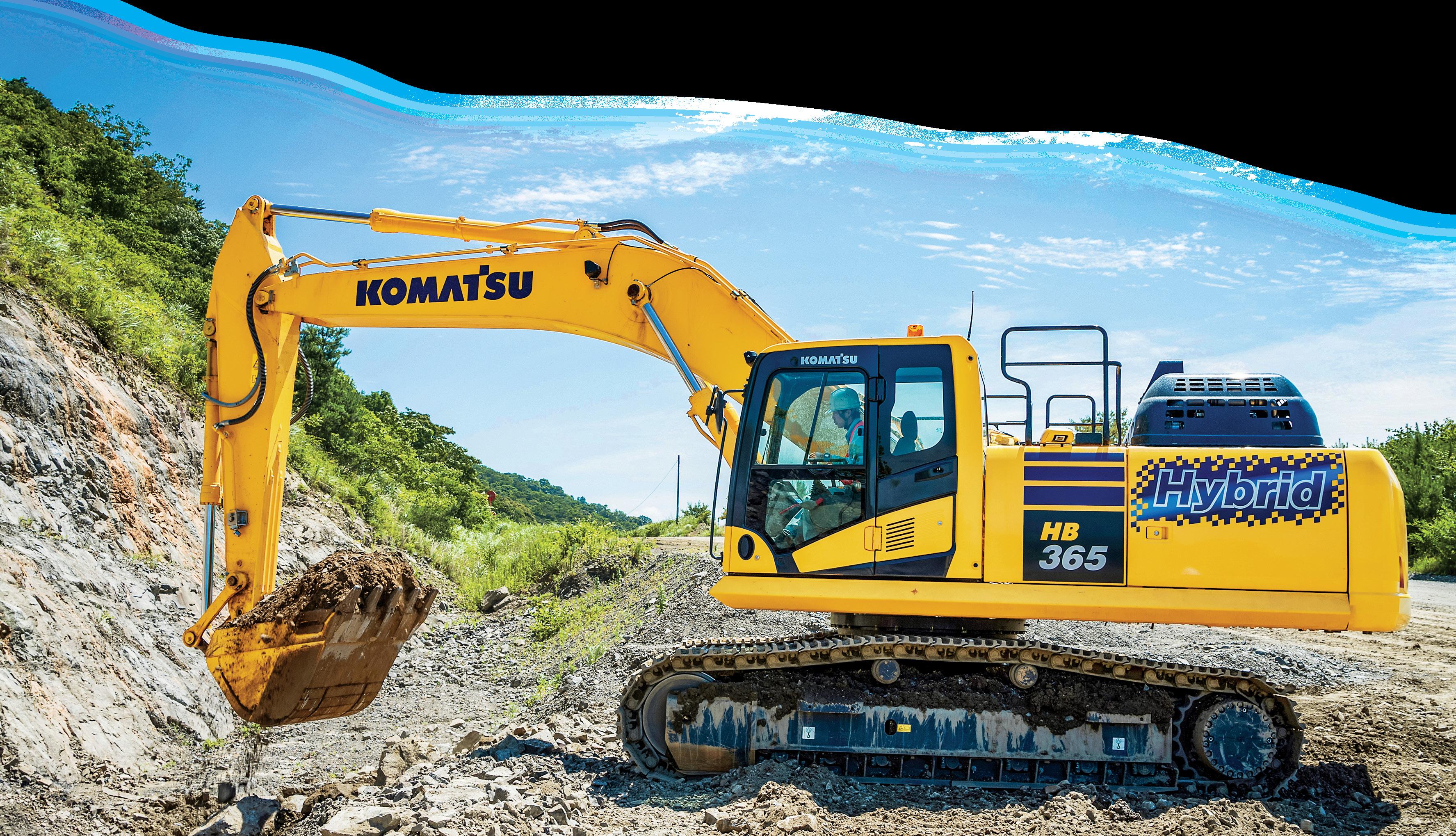
The energy captured during each swing braking cycle is stored in the Hybrid HB365LC-3’s ultracapacitor. Each time the excavator swings, the capacitor discharges electric power to the electric swing motor.
“A traditional battery requires time for the chemical process that releases electricity to occur,” stated Moncini. “The heavy work nature of construction equipment places a much faster demand on power transfer. The ultracapacitor’s ability to store and discharge energy quickly makes it ideal.”
He added, “When it comes to the boom arm and bucket, the capacitor drives the swing, and all available engine horsepower can go into the
12 Greener Excavator
Kurt Moncini, Senior Product Manager, Komatsu
hydraulic system. This creates faster cycle time and a very quick, responsive swing. It’s snappy.”
In addition to powering the swing motor, the ultracapacitor sends electric energy to the engine via the motor-generator. This energy is used to accelerate the engine from an ultra-low idle speed of 700 revolutions per minute (rpm) and improve hydraulic response.
Tier 4 and more
Komatsu recently improved the warranty on the HB365LC-3’s hybrid components. The special hybrid component warranty term is now up to seven years or 15,000 hours and covers the electric swing motor, motor-generator, capacitor and inverter. If you sell the excavator, the warranty is transferrable.
The Hybrid HB365LC-3’s 269-horsepower engine is a six-cylinder with a Komatsu aftertreatment system that meets U.S. EPA Tier 4 Final emissions regulations. A Komatsu Diesel Particulate Filter (KDPF) and Selective Catalytic Reduction (SCR) work together to inject Diesel Exhaust Fluid (DEF) and decompose nitrous oxide into non-toxic water and nitrogen.
Komatsu Care comes standard, including two complimentary KDPF exchanges and two SCR

services during the first five years with unlimited hours. It also covers scheduled maintenance for the first three years or 2,000 hours. All work is done by factory-trained distributor technicians. Hours and key performance data can be tracked remotely with Komtrax. Operators can see the information first-hand on the 7-inch, color LCD monitor, including a capacitor charge gauge, DEF levels and a rear-view camera. Komtrax has an Operator Identification System that records machine-operation and application data for up to 100 individual ID codes.
Operators will also appreciate lower noise levels in the spacious ROPS (roll-over protective structure)-certified cab. Features include vibration-dampening mountings and a fully adjustable, air-suspension seat and arm rests. A Bluetooth AM/FM radio is now standard on new machines.
“Users are raving about their productivity and cost savings,” said Moncini. “It’s not the right machine for every application or job site, but on those swing intensive jobs where it fits, it really stands out. We encourage anyone who uses excavators in the 36-ton class to contact their distributor for more information and to set up a demonstration.” ■

Quick Specs
Hybrid HB365LC-3
Horsepower 269 hp
Operating Weight 81,791-85,495 lbs.
Bucket Capacity 0.89-2.56 cu. yd.
13
“The Hybrid HB365LC-3 has equal or better performance than our standard PC360LC excavator, but with fuel savings that could be as high as 20%, depending on application,” said Kurt Moncini, Senior Product Manager, Komatsu. “It’s a great fit for construction companies that use excavators in high-swing applications, as well as for feeding crushers in quarry, recycling and demolition applications where swing is a constant.”
Model
more
Learn
Emery Sapp & Sons Inc. reduces costs by utilizing Smart Construction Remote to transfer files from the office to the field

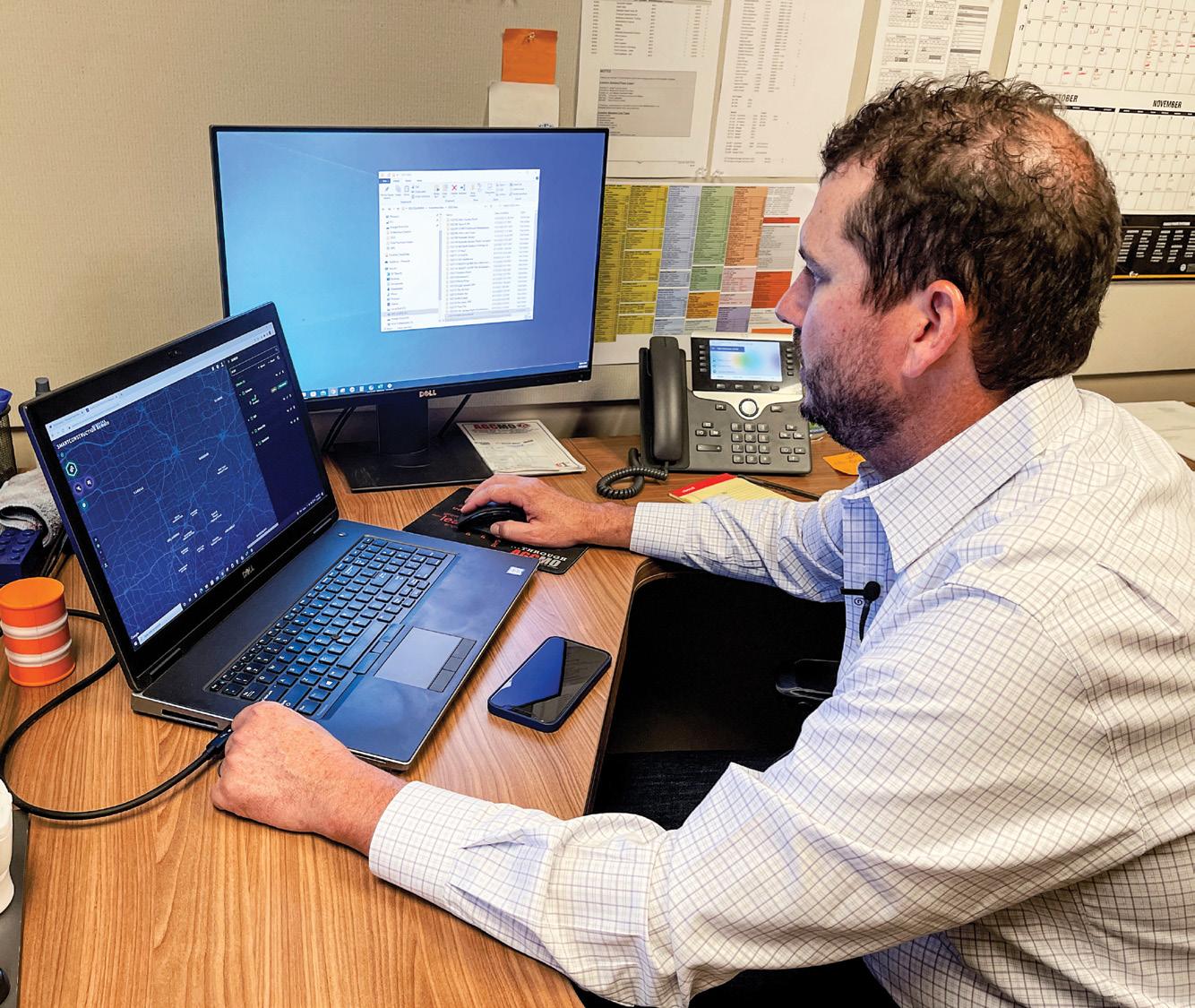
VValuing hard work, investing in its employees, adapting to the markets, and taking chances on new opportunities has made Emery Sapp & Sons Inc. (ESS) successful. For the past 50 years, that formula has propelled the Columbia-based firm into one of Missouri’s largest full-service civil contractors with about 1,800 employees.
“Our capabilities include everything from full site development to bridge installation to every aspect of paving,” said Tyler Grotewiel, Surveying and Construction Technology Manager. “We have over 200 projects in the works at any one time. In addition to core values, ESS has always been very forward-looking when it comes to adopting technology that increases efficiency on every site.”
One of the company’s earliest technology adoptions was adding aftermarket GPS grade control systems into its earthmoving operations, which improved its productivity.

More recently, ESS began utilizing Komatsu’s intelligent Machine Control (iMC) dozers.
“When I started here 17 years ago, we had a few machines with GPS, and now we have more than 100,” said Grotewiel, noting that ESS has also adopted GPS in its paving operations. “Knowing where you are in relation to final elevation and only having to move dirt once really increased our efficiency. It also cut costs because there is no rework, less wasted material, and no need for a grade checker. Every site we do now has a GPS model, whether it’s a small parking lot or a large highway job.”
“Solution we needed”

Grotewiel manages a group of about 30 people at ESS who focus on construction layout and prepare data files for machine control. About one-third of them are building 3D GPS models from the data as well as from CAD (computer-aided design) drawings from engineers and transportation departments.
“Our staff is outstanding at building accurate models that can be uploaded directly into the machines, but as anyone in the construction industry knows, plan changes are inevitable,” said Grotewiel. “In the past, that meant we had to physically drive to a project with a thumb drive to update files. Our projects are spread out across a large territory that covers multiple states, so it’s time-consuming and a major expense in fuel to do that. We were looking for a way to reduce or eliminate the hassle, and our research determined that Komatsu’s Smart Construction Remote was the solution we needed. The fact that it’s compatible with both Topcon and Trimble systems is a huge benefit. We have used it with both our Komatsu and competitive machines.”
Grotewiel added, “We compared it to other solutions in the market and found Smart Construction Remote to be more user-friendly, too. The process is simple. All you have to do is log into the website, find the machine or machines that you want to send the file to, and drag and drop the file to them. It’s nearly instantaneous, and the operator doesn’t have to do anything. We have four offices, and I estimate that we use Smart Construction Remote about 15 times per week at each one. I don’t have to
Tyler Grotewiel, Surveying and Construction Technology Manager at ESS, updates plans on machines in the field from his office with Komatsu’s Smart Construction Remote. “The process is simple,” said Grotewiel. “All you have to do is log into the website, find the machine or machines that you want to send the file to, and drag and drop the file to them. It’s nearly instantaneous, and the operator doesn’t have to do anything.”
Watch the video
14 Customer Success Story
Tyler Grotewiel, Surveying and Construction Technology Manager
pay someone to drive the file to the job site, and the operators get the information faster.”
See what the operator does
If an operator has a question or an issue, Grotewiel and his team can assist them from the office because Smart Construction Remote allows direct remote access to a machine.
“Instead of having to drive to the site, we can see what the operator sees on the screen in the machine,” said Grotewiel. “If necessary, I can actually take control remotely to directly address the issue.”
Operator Gage Snider says Smart Construction Remote has also notably increased the company’s production.

“If there is an update, it’s just done,” stated Snider. “You don’t have to wait on somebody to show up. It comes to the machine and is done automatically, so I keep moving dirt without having to worry about the plan being outdated. Because it’s done remotely, most of the time I don’t even know it’s been done.”
Initial setup, ongoing support
ESS worked with its local Komatsu distributor to access Smart Construction Remote. Distributor representatives helped ESS with the setup, including the installation of cellular modems that are used for communication to load and update plans.
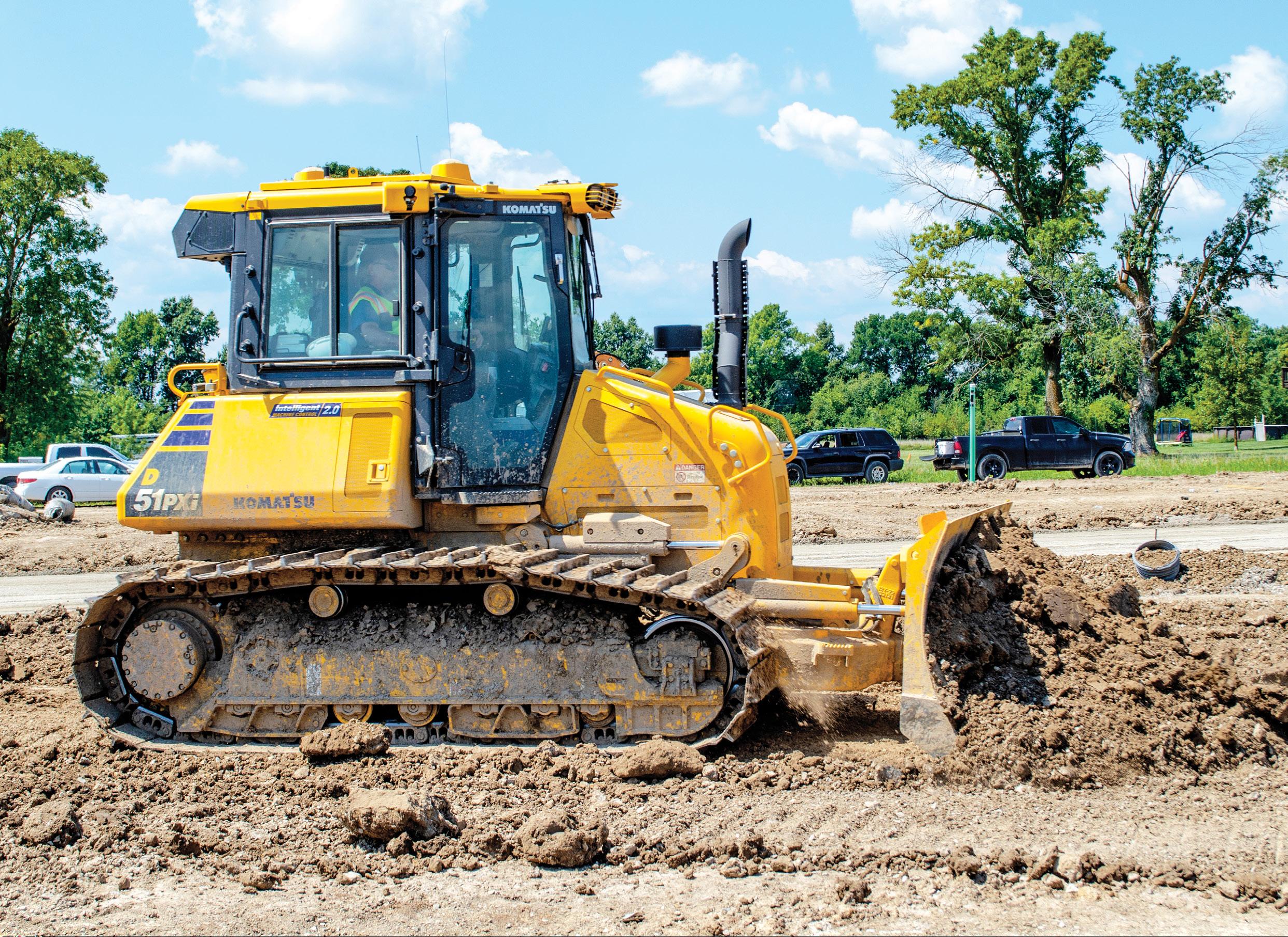
“They remain an invaluable resource because they guided us through the initial setup, helped us through the learning curve, and provide ongoing support,” said Grotewiel. “As we were adding Smart Construction Remote, our modems had to be upgraded to 4G, which was a big undertaking, and they were there every step of the way. They have ensured our successful use of Smart Construction Remote. Because of that — and the savings we are seeing — our plans include working with them to add it to more machines. We highly recommend Smart Construction Remote.” ■
**The opinions expressed here are from the end users who are quoted.
With Komatsu’s Smart Construction Remote, ESS can send plans and updates to its machines without driving to the job site. “Our projects are spread out across a large territory that covers multiple states, so it’s time-consuming and a major expense in fuel to do that,” said Tyler Grotewiel, Surveying and Construction Technology Manager. “Komatsu’s Smart Construction Remote was the solution we needed.”
15
Gage Snider, Operator
SILENT PUMP. SIZED FOR PERFORMANCE.






Gorman-Rupp Prime Aire® sound-attenuated pumps are engineered to operate much quieter than industry standards. And, they are now available in sizes up to 14” with flows up to 10,000 GPM to handle your toughest bypass and dewatering applications. Features include spill containment environmental base, corrosion-resistant, acoustically treated enclosure and the latest in Tier IV engine-driven technology.
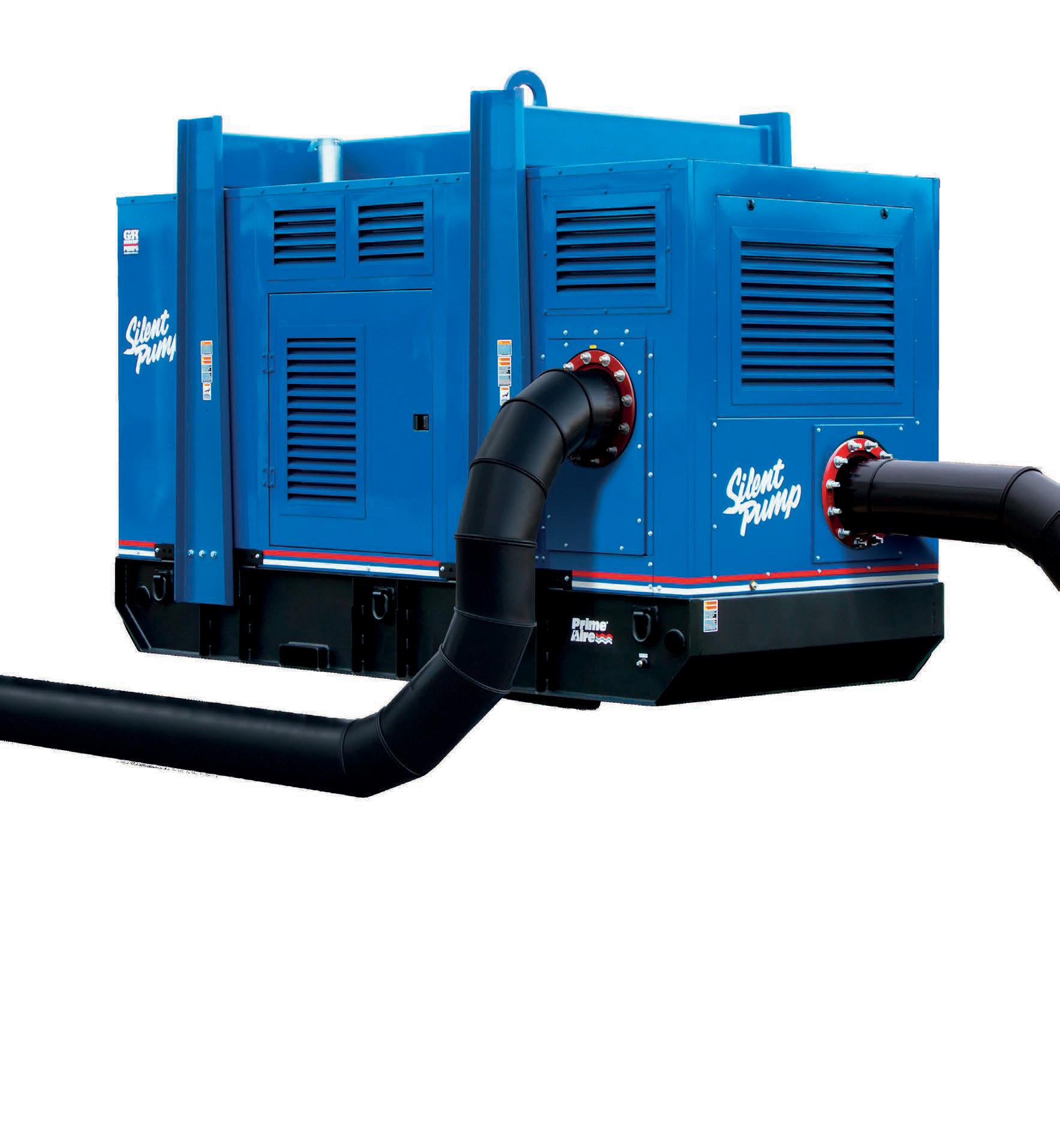
(Corp) San Diego 7651 Ronson Road (858)278-8351 San Diego 4726 Con voy Street (858)278-8338 Escondido 1330 Mission Road (760)739-9100 Fontana 8520 Cherr y Avenue (909)429-9100 Indio 81-501 Industrial Place (760) 863-5558 Imperial 440 W. Aten Road (760)355-7700 www.clairemontequipment.com
Reman NOx sensors deliver optimal performance while lowering costs, controlling emissions and promoting sustainability
EEquipment users often think of remanufacturing when it comes to engines and large components because the cost savings are significant, and they are getting “like-new” with a warranty. However, you could also save resources with smaller remanufactured items you may not have considered.
“NOx (nitrogen oxides) sensors are a great example of a high-quality, low-cost replacement option that help avoid breakdowns and reduce owning and operating expenses,” said Komatsu’s Goran Zeravica, Senior Product Manager, Reman. “A Reman NOx sensor protects your diesel engine’s aftertreatment system and promotes optimal performance with the added benefit of lowering emissions and promoting sustainability.”
Komatsu genuine Reman NOx sensors meet original equipment specifications, assembly processes and test procedures to match the performance of a new part. They help equipment users stay in compliance with regulations while maintaining productivity. Komatsu genuine Reman NOx sensors can also help you:
• Avoid maintenance issues with new/upgraded probe tips fitted with an anti-seize lubricant that is pre-applied to the sensor threads
• Reduce wear with watertight inline connectors that verify electronic continuity between the probe and the control module
• Operate predictably with limited data from the control panel, including temperature, mileage and hours
• Reduce waste and save natural resources by reusing and salvaging components
Get the credit you deserve Zeravica noted that sensor probes are a common failure, so remanufactured NOx sensors are fitted with new probe tips. Once the sensor probe is replaced, Komatsu Reman NOx sensors are calibrated and bench tested. Reman components are backed by a one-year, unlimited-hour warranty.
“We highly encourage that you return your used NOx sensor, so you get full core credit, even if the probe has been cut,” said Zeravica. “Contact your Komatsu distributor for additional details and work with them to acquire the right sensor and for proper installation.” ■


To learn more about Komatsu Reman, visit https:// www.komatsu.com/services-and-support/equipmentreman-assembly/
A Komatsu genuine Reman NOx sensor protects your diesel engine’s aftertreatment system and promotes optimal performance. The low-cost, like-new replacement can help you avoid breakdowns and reduce expenses.

17 Savings for You
Goran Zeravica, Senior Product Manager, Reman, Komatsu
Discover more
Smart Construction and Smart Quarry Demo Days introduces customers to suite of Komatsu-backed solutions
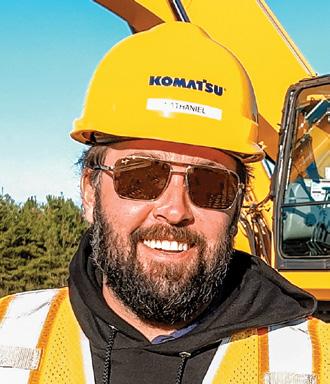
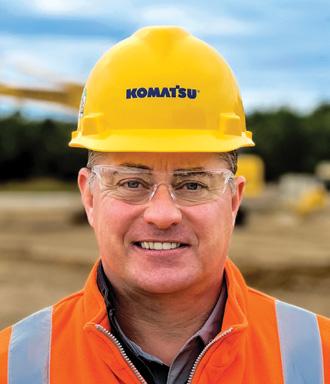
KKomatsu customers from around the United States and Canada learned about Komatsu’s suite of Smart Construction solutions — including its newest addition, Smart Quarry — and intelligent Machine Control (iMC) at Komatsu’s Smart Construction and Smart Quarry Demo Days. The four-day event took place at Komatsu’s Training Center in Cartersville, Ga. “Customers rotated between seven Smart Construction, Smart Quarry and iMC stations,” explained Komatsu Senior Product Manager Brandon Rakers. “In the morning, they spent 15 to 20 minutes learning about each solution from a product specialist. After a catered lunch break, they had the opportunity to operate several of our iMC and legacy retrofit machines as well as talk with specialists to dive deeper into solutions they found beneficial to their business.”
The Smart Construction stations included information about: Quarry, Dashboard, Design, Drone, Field, Fleet, Office, Remote, Retrofit, and iMC.
“We’ve found that customers are looking for solutions but don’t allot time to get in depth with them,” noted Rakers. “This event allowed them
to dedicate that time toward hands-on learning about each solution and how they’re all connected. Ultimately, a digital job site is the way of the future, and we want our customers to understand how these solutions can increase productivity and supplement the machines and processes they already have in place.”
Smart Construction interconnectivity
Each Smart Construction solution helps improve job site efficiency. When several are used together, the solutions communicate to maximize your productivity. For example, Smart Construction Fleet, Field and Office are an ideal group.

“Smart Construction Field is a mobile app meant to tie your production and costs to your daily work, so there’s never any worry about what’s getting done on a day-to-day basis,” explained Komatsu Smart Construction Solutions Manager Christine Watters. “Our web-based platform, Smart Construction Office, will consolidate the information from Field and Fleet into reports, which you can then use to print out daily reports across your entire project portfolio. That gives you a full visual on what Smart Construction is doing for you, and most importantly, how efficiently your job sites are operating.”

While Smart Construction Fleet is geared toward the construction industry, Smart Quarry provides fleet monitoring solutions for mining operations.
“We previewed our Smart Quarry solution, which lets machines communicate with each other, share production information, and track the fleet,” said Komatsu’s Bruce Boebel, Director of Product and Services for Wheeled Products in North America.

“This allows you to optimize fleet operation in a quarry by monitoring fuel consumption, machine data, cycle times, idle time and other data points. It’s actionable data you can use to increase operator efficiency.”
If you’re outsourcing 3D modeling services, Smart Construction Design is Komatsu’s 3D data generation service, which provides your company with accurate models to ensure your team can focus on core business operations. Through Smart Construction Dashboard, you can combine 3D data with aerial mapping captured through Smart Construction Drone technology and data from iMC and retrofit machines to confirm quantities and visualize progress. When job site
Bruce Boebel, Director of Product and Services for Wheeled Products in North America, Komatsu
Brandon Rakers, Senior Product Manager, Komatsu
Christine Watters, Smart Construction Solutions Manager, Komatsu
Attendees access Smart Construction Remote on a tablet to monitor their iMC equipment in real time. The data is transferred to Smart Construction Dashboard. “This event allowed them to dedicate that time toward hands-on learning about each solution and how they’re all connected,” said Komatsu Senior Product Manager Brandon Rakers.
18 Smart Showcase
Nathaniel Waldschmidt, Product Manager, Komatsu
plans change, remotely upload files from your office to an iMC machine or log into a machine to view and interact with your operator’s screen through Smart Construction Remote.
Machine capabilities


On the equipment side of the event, Komatsu exhibited the new PC490LCi-11 iMC 2.0 excavator, a PC210LCi-11 iMC excavator equipped with automatic bucket angle technology, additional iMC dozers and excavators, and legacy excavators retrofit with indicate-only GPS systems.
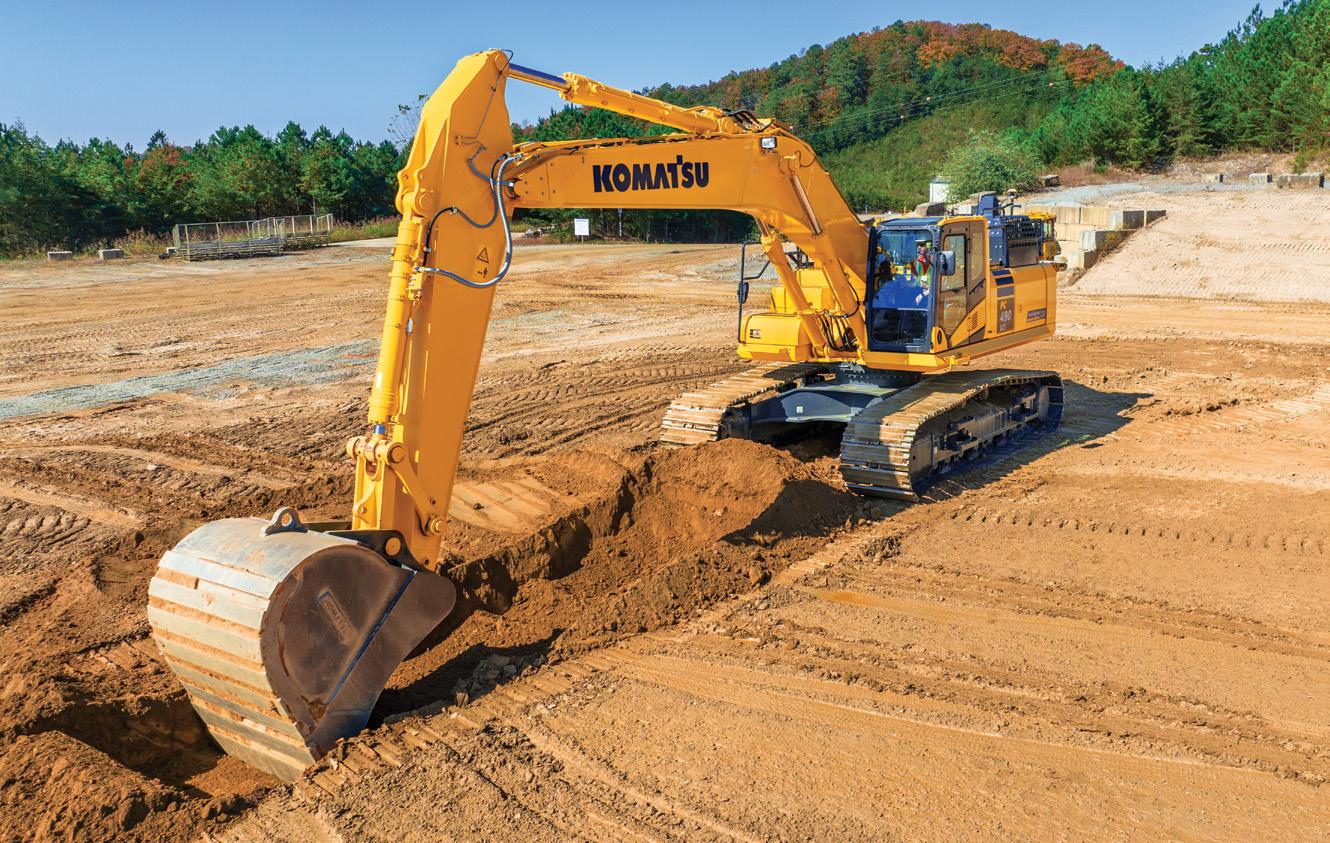

“The PC490LCi-11 excavator is our largest excavator that features iMC 2.0,” said Komatsu Product Manager Nathaniel Waldschmidt. “It blends mass excavation and precision grading capabilities. This machine can tackle various ditching, trenchwork, and other underground applications without over- or under-digging.”
Waldschmidt continued, “We outfitted our PC210LCi-11 excavator with a bucket and coupler to demonstrate our auto bucket angle technology. All of our iMC 2.0 machines can use the technology. It automatically holds the bucket angle for an operator through an entire pass for precision cutting along slopes and trenches.”
The retrofit technology displayed how legacy excavators can help increase operators’ efficiency with stronger digital capabilities.
“Retrofit brings everything to light,” said Rakers. “It’s a solution for our customers using legacy
excavators, tight tail swing excavators and our larger excavators that don’t have iMC capabilities. From both the retrofit and iMC machines, you can generate as-built data to feed back into Smart Construction Dashboard. That feeds into our goal behind Smart Construction: creating a digitally connected community. Eventually, we want to digitize the entire job site to improve your process from first cut through final pass.” ■
19
A Komatsu representative explains Komatsu’s retrofit program, which outfits legacy excavators with indicate-only GPS systems.
An operator cuts a ditch with a Komatsu PC490LCi-11 intelligent Machine Control (iMC) 2.0 excavator. “(Attendees) had the opportunity to operate several of our iMC and legacy retrofit machines as well as talk with specialists to dive deeper into solutions they found beneficial to their business,” said Komatsu Senior Product Manager Brandon Rakers.
Watch the videos
On the light side
“Tech support? I want to get my grades encrypted.”
“Even if you and your friends do drink to each other's health, you can't use your bar tab for a medical expense.”

Did you know?
• Bats are the only mammal that can fly.
• In the 1920s, Lincoln Logs were created by John Lloyd Wright, son of famous architect Frank Lloyd Wright. They were named after Abraham Lincoln, who grew up in a log cabin.
• The difference between jelly and jam is that jelly is made with fruit juice while jam is made with mashed up fruit
“You call that a business organizational chart, Hackwood? It looks just like the NCAA basketball Sweet Sixteen.”

Brain Teasers


Unscramble the letters to reveal some common construction-related words. Answers can be found in the online edition of the magazine at www.CECPushingAhead.com
1. ZRODE __ __ __ __ __

2. BCA __ __ __

3. PREIPR __ __ __ __ __ __



4. CSRKAT __ __ __ __ __ __
5. ELBDA __ __ __ __ __
• Worldwide, there are an estimated 16 million thunderstorms each year, and at any given moment, there are roughly 2,000 thunderstorms in progress.
• The origin of the word “sinister” reflects a historical bias against left-handed people. It comes from the Latin word for “left,” which was also seen to be unlucky or evil.
• Hawaiian pizza was created in Ontario, Canada, by Greek immigrant Sam Panopoulos in 1962.
• 2023 is the Year of the Rabbit, according to the Chinese zodiac.
20
Side Tracks
storage and handling of your equipment’s batteries ensure safety, help maintain peak performance
BBatteries are crucial to your equipment’s productivity, and properly caring for them can ensure their performance and longevity. Here are some tips to prepare batteries for storage, so they are ready to work when you are.
“Safety is of utmost importance because batteries generate explosive hydrogen gas,” emphasized Komatsu’s Veronica Vargas, Product Manager, Parts. “Always wear safety glasses, a face shield and proper gloves when working on or near them. Batteries also contain corrosive sulfuric acid that can destroy clothing and burn the skin. Neutralize acid spills with a paste made of baking soda and water or large quantities of water.”

To stay safe when handling batteries, remember these tips:
• Keep sparks, flames and cigarettes away from batteries
• Do not connect or disconnect “live” circuits
• Always turn charging and testing equipment off before attaching or removing clamps to avoid creating sparks
• Perform work in a ventilated area
• Never lean directly over a battery while boosting, testing or charging it
Always store batteries in a cool, dry place, and do not store batteries outside or high on racks. Add demineralized water to non-maintenance-free batteries as required.
Test, inspect
When it’s time to use the batteries again, testing should be done prior to installation. Use load testers to simulate starting, and test for conductance and voltage. Charge batteries, if necessary.
“Just as you do with batteries, it’s important to maintain testing and charging equipment,” said Vargas. “Clean the terminals and cable ends. Check for correct output, check leads for corrosion, and change leads annually. As you prepare to test the batteries, check them for any signs of damage, and if there is any, or if there is any doubt about their safe usage, replace them immediately as usage may lead to severe consequences.”
Vargas concluded, “If you take care of batteries, they will take care of you. We recommend that when it’s time to replace them, you use genuine Komatsu products from your Komatsu distributor.” ■
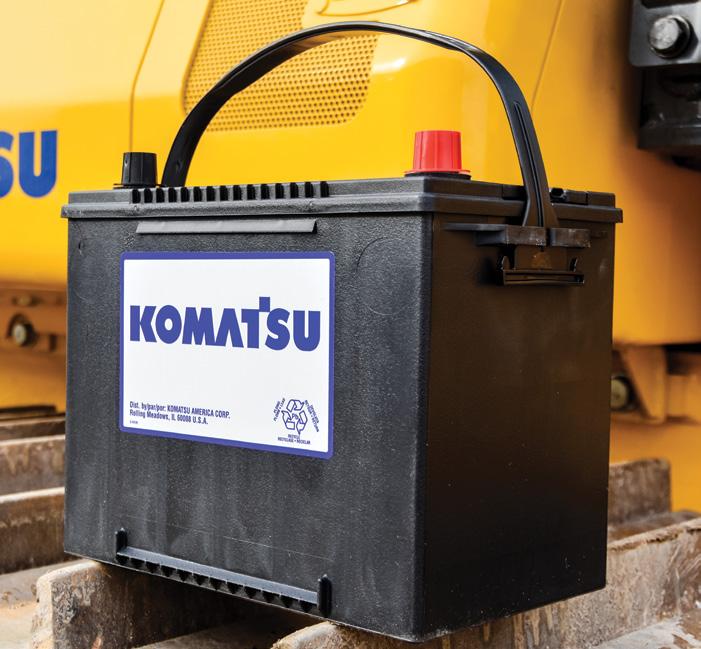
Proper battery care ensures your equipment’s productivity and long battery life. If you are storing batteries, it’s essential to follow safety guidelines.
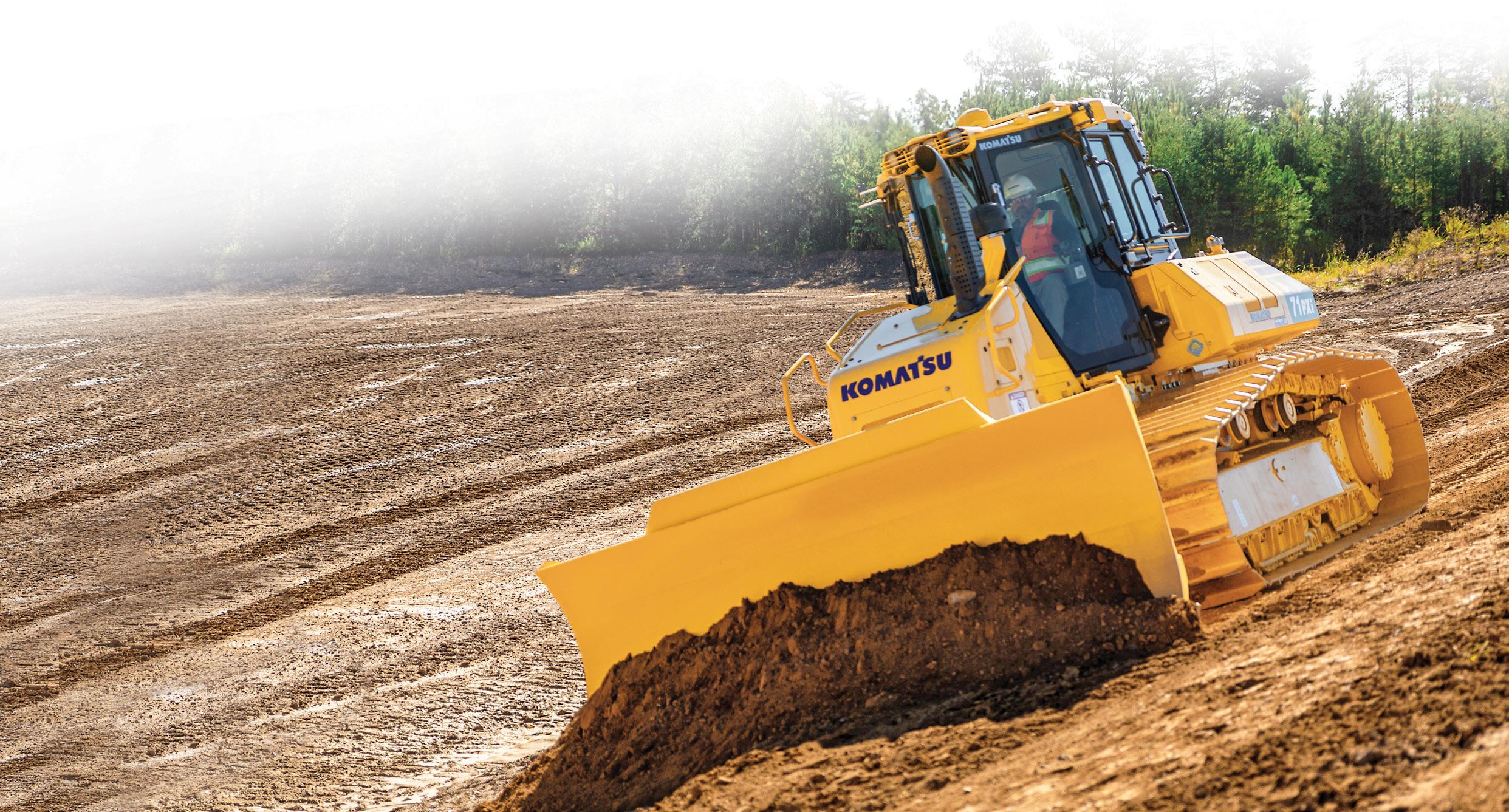
Proper
21 Battery Maintenance
Veronica Vargas, Product Manager, Parts, Komatsu
Smart Construction Retrofit equips legacy machines with 3D guidance and payload monitoring — tools to drive accuracy and efficiency at your job site.

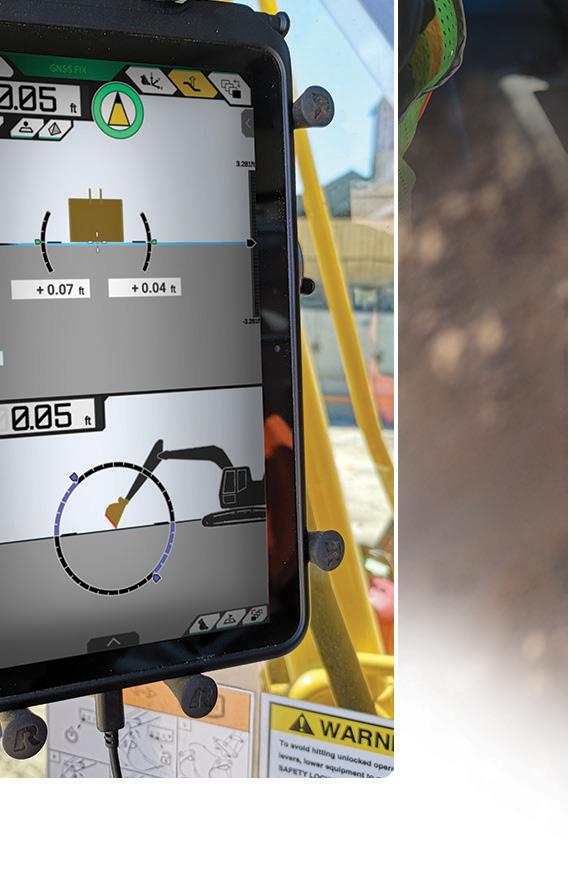

Learn more about this exciting new solution at komatsu.com/smart-construction-retrofit








Now there is an easy, affordable way to bridge the technology gap
Scan to learn more
Heat increases rates of traumatic injuries for construction workers, according to Oregon State University study
RRates of traumatic injury among workers in construction and agriculture are significantly higher during periods of high heat versus more moderate weather, according to an Oregon State University (OSU) study. Researchers said the results highlight the importance of providing robust safety protections for outdoor workers, especially in extreme heat events.

“The big take-home message I want people to get from this is that, if the temperature is high and you have workers out there, they’re more likely to be injured, whether it’s due to dehydration, reduction in mental capacity or exhaustion,” said Richie Evoy, lead author on the paper and a recent doctoral graduate from OSU’s College of Public Health and Human Sciences.
The study looked at Oregon workers’ compensation data from 2009-2018, with researchers studying nearly 92,000 claims involving temporary or permanent disability or death. They focused on injuries that occurred in the months of April through October because the average heat index was above 55 degrees during that period.
Researchers found that construction and agriculture workers were significantly more
likely to suffer a traumatic injury on days when the heat index was above 75 degrees, compared to a 65-degree or less baseline. The effect worsened when the heat index was above 90 degrees, with an increased risk of 19% to 29% over baseline as the index ranged from 90 to 119 degrees.
“These results support the need for occupational safety practitioners to include protections for workers during extreme heat,” said Laurel Kincl, co-author of the study and an associate professor in OSU’s College of Public Health and Human Sciences.
“While our study is based in Oregon, this is true of other states and regions since these conditions will likely become more frequent with climate change.”
The other co-authors of the OSU study were Perry Hystad and Harold Bae, who are both in the College of Public Health and Human Sciences. The researchers also studied the impact of wildfire smoke on injury rates. ■
To learn more about the study, read the article by Molly Rosbach on OSU’s website at https://today. oregonstate.edu/news/osu-study-finds-higherrates-traumatic-injuries-outdoor-workers-duringhotter-weather
An Oregon State University study found traumatic injury rates climbed as temperatures soared. Researchers said the results highlight the importance of providing robust safety protections for outdoor workers, especially in extreme heat events.
Industry Insight
23




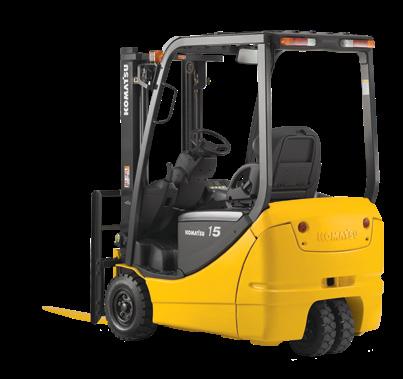


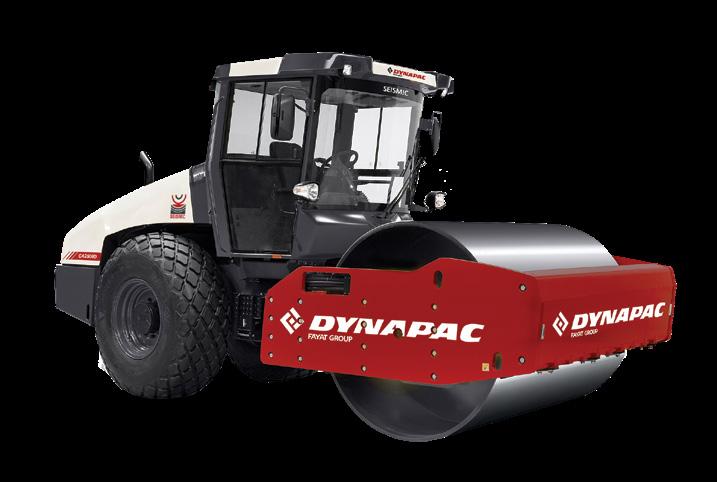

San Diego, CA (Corporate) 7651 Ronson Road (858) 278-8351 San Diego, CA 4726 Convoy Street (858) 278-8338 Escondido, CA 1330 Mission Road (760) 739-9100 Fontana, CA 8520 Cherry Avenue (909) 429-9100 Indio, CA 81-501 Industrial Place (760) 863-5558 Imperial, CA 440 W. Aten Road (760) 355-7700 Not all products represented at all locations. www.clairemontequipment.com Fontana Escondido San Diego Indio Imperial C.P.I. P.O. Box 1689 C.R., IA 52406-1689 Presorted Standard US Postage Paid C.P.I. 23-01 QUALITY PRODUCTS supported by SUPERIOR CUSTOMER SERVICE Serving southern California since 1970
























 Komatsu’s Jason Anetsberger (left) uploads data from the Smart Construction Drone flights to Smart Construction Dashboard. Castle’s Joel Brewton (right) uses Komatsu’s Smart Construction Dashboard in his office in Meridian, Miss., to check the progress of Castle’s job sites in Wisconsin.
Chris Scheve, Vice President, Renewable Energy
Komatsu’s Jason Anetsberger (left) uploads data from the Smart Construction Drone flights to Smart Construction Dashboard. Castle’s Joel Brewton (right) uses Komatsu’s Smart Construction Dashboard in his office in Meridian, Miss., to check the progress of Castle’s job sites in Wisconsin.
Chris Scheve, Vice President, Renewable Energy

 **The opinions expressed here are from the end users who are quoted.
**The opinions expressed here are from the end users who are quoted.






















































